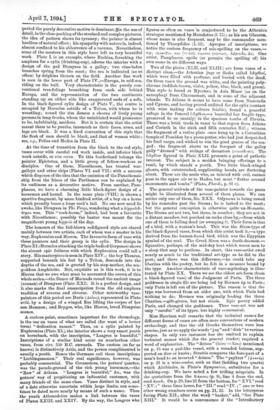BOOKS.
GREEK VASE-PAINTINGS.*
IN this beautiful book an admirable idea has been admirably executed. Choice examples of Greek vase-painting are pre- sented in a series of forty-three plates, reproduced from all available sources—the folios of collectors, the transactions of learned societies, and the works of students, Italian, German, French, and English. The book "addresses itself to artists, and to the amateurs of fine design ; " and the examples have been selected entirely for their merit as de- signs, irrespectively of the forms of the vases from which they are taken. They are arranged in chronological order (so far as any strict chronology is possible), the period covered being roughly from about 550 B.C. to 450 B.O. The intro- duction by Miss Harrison—which is described, with almost excessive modesty, as a "Historical Note "—gives, within the compass of twenty-four folio pages, a concise but clear account of the processes by which vases were made and painted ; of their principal forms and uses; of the methods by which (with help from their inscriptions) they can be dated; and of what is known as to the principal artists in this province, their traditions, their influence on each other, and their general attitude towards the sources, literary or artistic, of the subjects which they depicted. The exposition has strict reference to the plates contained in the volume, and is expressly guarded against any claim to be a history of Greek ceramography ; nevertheless, it has, for the general student, the value of a sketch in which the essential features of the whole subject are marked with that sureness of touch which can come only from fullness of knowledge. As Mr. D. S. MacColl says in the Preface, the literature of Greek vases, a large one, is "a literature of specialists, and one to • Greek Vase-Paintings. A Selection of Example,. with Preface. Introduc- tion. and Descriptions. By J. E. Harrison and D. S. IdacColl. London: Fisher Unwin.
which the unlearned artist or amateur has no guide." Such a guide, both lucid and delightful, is supplied here ; and to say nothing of "amateurs of design," there are probably few cultivated readers, or, for that matter, scholars, who will not find it fall of pleasurable instruction.
In the course of the century or so during which Greek vase- painting was at its best, the art passed through the two phases known as "black-figured" and "red-figured." In both, the red clay vase was the basis : but in the first, the figures were put on in black; in the second, it was the ground that was blackened, while the figures were left red. The technique was different in the two cases ; each may be shortly described in Miss Harrison's words :—
" In the black-figured style, the first step was to draw the required figure or design in outline on the red ground. The silhouette was then filled in with a larger brush and the vase fired. It is often quite easy in black-figured vases to make out the preli- minary outline, at least in parts. The result so far obtained was of course nothing but a black silhouette, and when many figures were crowded together or overlapped, the design would become unintelligible. To obviate this, and to give greater scope for the expression of detail, came the next step, that of putting in the incised lines. With a sharp graving tool the vase painter cut clean through the black ground to the natural clay of the vase. Incised lines are used sometimes for the outlines of figures, in which cases they often correct the painted outline, constantly for the drawing of eyes, hair, and every sort of accessory in drapery and decoration."
In the red-figured vase, on the other hand,— " The colour of the ground forms the figures, and the remainder of the ground is covered over with black. The problem is to leare the exact outline wanted. It will be seen at once that this is a much more delicate business ; accordingly we have added a preliminary step. The artist takes a blunt ivory tool, and roughly indicates the outline of his figures with this on the soft [unfired] clay. The outline, even after firing, can often be quite dearly seen. Most of it is, of course, painted over, but in places where the black ground does not cover it. it can easily be made out. Sometimes it is corrected again and again. Once this outline secured, the artist could take his brush in comfort and do it over in black paint, —i.e., outline the figures from the outside—he only needed to be careful of his inside line The next stage was probably undertaken by a subordinate workman, as the artist would not trouble to fill in the black ground. It wanted only careful, even, brush-work. When this black glaze had been smoothly laid over the whole background, the vase was fired at a great heat, and with extreme care. Next came the question of details in red-figured vases, these were put in in dull red, palish yellow, purple. Incised lines gradually fell out of use, but in early red-figured vases they are used, e.g., for the outline of the
hair, &c It may be taken generally that all indications of internal anatomy" (as ribs and muscles) "are given in a colour which is in reality nothing but the black glaze thinned down into various brownish shades as desired. At this stage, too, inscrip- tions and artists' signatures are added, and the vase was finally fired, but only at a slight heat."
The general chronology of the black and red periods has now been settled beyond dispute. As long ago as 1835, Lud- wig Ross, in excavating south of the Parthenon, found a layer of debris, bearing traces of fire, which (from the depth at which it was found) he rightly inferred to be remains of objects destroyed when the Acropolis was sacked by the
Persians in 480 B.C. In this layer there was a bit. of a red- figured plate. He concluded that the red-figured style was in use, and highly developed, before 480 B.C. His discovery, though not ignored, failed to convert archwologists, who per- sisted in putting the red-figured style later. But the excava- tions begun on the Acropolis in 1887 disclosed a whole series of red-figured fragments in the " pre-Persian " layer. There is no longer any doubt that some of the best red-figured work bad been done before 480 B.C., and that the beginnings of the style cannot be put below 510-500 B.C. Other data confirm this. One of the masters in the black-figured style, Exekias, in signing his name on an amphora, has used the koppa ( ? , the Latin q) for z, and this points to a date earlier than the close of the sixth century B.C. The activity of Exekias must be placed in the earlier part of the second half of that century. We may say roughly that the black-figured style, beginning early in the sixth century, was at its zenith from about 550 to 510 B.C., and the red-figured (after a tentative or transi- tional stage) from about 500 to 450 B.C.
In the black-figured period the form of vase which chiefly employed painters was the amphora, a storing vessel with large body, narrow neck, and two handles. It was due to the handles that the design, instead of being carried continuously round the vessel, was broken into obverse and reverse ; and this
sense of back and front constantly appears in the black-figured art, even when applied to other forms. In the black figured -.period the purely decorative motive is dominant lin the use of detail, in the close packing of the strained and complex pictures, the idea of pattern shows its tyranny; the painter is almost heedless of natural effect ; his sympathy with nature is, indeed, almost confined to his abhorrence of a vacuum. Nevertheless, some of the masters in this style have left us very beautiful work. Plate L is an example, where Exekias, forsaking the amphora for a cylix (drinking-cup), adorns the interior with a -design of the god Dionysus in a galley ; two vine-laden branches spring from the mast ; the sea is indicated (as so -often) by dolphins thrown on the field. Another fine work is seen in the lower part of Plate IV.,—Europa, in mid-sea, riding on the bull. Very characteristic is the purely con- ventional tree-foliage branching from each side behind Europa, and the representation of the two continents -standing up on either side like exaggerated ends of a sofa. In the black-figured cylix design of Plate V., the centre is occupied by Heracles astride of a Triton, with whom he is wrestling; round the rim dances a chorus of lively young .persons in long frocks, whom the uninitiated would pronounce to be, indubitably, maidens. But it is certain that the artist meant them to be youths, inasmuch as their faces, arms, and legs are black. It was a fixed convention of this style that the flesh of men should be black, and that of women white ; see, e.g., Pelias and Medea in Plate IL
At the time of transition from the black to the red style, vases occur with careful red work inside, and inferior black
work outside, or vice versa. To this borderland belongs the
painter Epictetus, and a little group of fellow-workers or disciples. One of these, Nicosthenes, has treated war.
galleys and other ships (Plates VI. and VII.) with a success which disposes of the idea that the omission of the Panathenaic ship from the frieze of the Parthenon can be explained by its unfitness as a decorative motive. From another, Pam- phaeus, we have a charming little black-figure design of a horseman and hound. In the same plate (VIII.) is shown a -sportive fragment, by some kindred artist, of a boy on a horse
which proudly bears a huge cock's tail. No one now need lie awake, like Dionysus in The Frogs, wondering what a hippaleh.
tryon was. This "cock-horse," indeed, had been a favourite with Nicosthenes ; possibly the banter was meant for the magnificent young hippeis of the day.
The honours of the full-blown red-figured style are shared mainly between two artists, each of whom was a master in his way, Euphronius and Hieron. The favourite form of vase with these painters and their group is the cylix. The design in Plate XI. (Heracles attacking the triple-bodied Geryones) shows
the almost epic fullness with which Euphronius could tell a story. His masterpiece is seen in Plate XIV. ; the boy Theseus, supported beneath his feet by a Triton, descends into the depths of the sea, and is greeted by his step-mother, the sea- goddess Amphitrite. But, exquisite as is this work, it is to heron that we owe what must be accounted the crown of this whole series,—the Dance of Maenads round the ancient image (xoanan) of Dionysus (Plate XXI). It is a perfect design, and it also marks the final emancipation from the old amphora tradition of reverse and obverse. Other noteworthy vase- painters of this period are Darla (4,0Digt;), represented in Plate xviii. by a design of a winged Eos lifting the corpse of her son Memnon; and Brygos, who, like Hieron, loved Dionysiac scenes.
A curious point, sometimes important for the chronology, is the use on vases of what are called (for want of a better term) "dedication names." Thus, on a cylix painted by Euphronius (Plate XI.), the interior shows a very smart youth on horseback, with the inscription, " Leagros is beautiful." Inscriptions of a similar kind occur on numberless other vases, from circ. 550 B.C. onwards. The custom (so far as known) is distinctively Attic, and the person complimented is usually a youth. Hence the Germans call these inscriptions " Lieblingsnamen." Their real significance, however, was probably commerciaL The Cerameicus, the potters' quarter, was the parade.ground of the rich young horsemen,—the "Row" of Athens. " Leagros is beautiful," &c., was the potters' way of propitiating an influential customer, with many friends of the same class. Vases distinct in style, and -of a date otherwise uncertain within large limits, can some- times be dated more nearly by means of such a name. Thus the youth Athenodotus makes a link between the vases of Plates XXL1I. and XXIV. By the way, the Leagros who figures so often on vases is conjectured to be the Athenian strategus mentioned by Herodotns (9. 75) ; as his son Glauoon, whose name is also frequent, may be the commander men- tioned by Thncydides (1.51). Apropos of inscriptions, we notice the curious frequency of mis-spelling on the vases,- e.g., EypacrePEv, rut (=Irk), TEporay (pron.), Agpovas, &o. One artist, Pamphaens, spells (or permits the spelling of) his own name in six different ways.
Two of the plates (XLII. and XLIII.) are from vases of a distinct class,—the Athenian jugs or flasks called lekythoi, which were filled with perfume, and buried with the dead. On these vases the ground was white, and the painting poly- chrome (reddish-brown, violet, yellow, blue, black, and green). This style is found at Mycenae, in Asia Minor (as on the sarcophagi from Clazomenae), and in some of the adjacent islands. To Athens it seems to have come from Naucratis and Cyrene, and having proved unfitted for the cylix (contact with wine making the colours friable), found a peaceful refuge in the funeral lekythos,—a beautiful but fragile type, preserved to us (mainly) in the spacious tombs of Etruria. There was a brisk trade in vases to that region from Athens and Corinth in the sixth and fifth centuries B.C. ; witness the fragment of a votive plate once hung up in a Corinthian temple of Poseidon by a pious potter, who had just despatched his frail cargo, and wished to win the good graces of the sea. god : the fragment shows us the forepart of the galley gaily " dressed " with strings of decanters (oenochoae). The lekythos figured in Plate XLII. presents a point of pathetic interest. The subject is a maiden bringing offerings to a tomb, by which stands a youth. Two little black-winged ghosts, with outstretched, supplicating hands, are fluttering about. These are the souls who, as tainted with evil, cannot pass to the upper air or to Hades, but must "flutter around monuments and tombs" (Plato, Phaedo, p. 81 c).
The general attitude of the vase-painter towards the poets might be illustrated from several of these plates. We can notice only one of them, No. XXX. Odysseus is being rowed by his comrades past the Sirens; he is lashed to the mast; but the general conception is otherwise quite un-Homeric. The Sirens are not two, but three, in number ; they are not in a distant meadow, but perched on rocks close by,—from which one of them is falling dead (or swooping P). Their form is that of a bird, with a woman's head. This was the Siren-type of the black.figured vases, from which this artist took it,—a type derived from the human-faced bird, which was the Egyptian symbol of the soul. The Greek Siren was a death-daemon,- figurative, perhaps, of the mid-day heat which wooes men to a sleep that may be perilous. In short, this vase-artist owed nearly as much to the traditional art-type as he did to the poet; and there was this difference,—he could take any liberties with the poetry, but he felt in a measure bound by the type. Another characteristic of vase-mythology is illus- trated by Plate XX. There we see the oldest art-form (from a black-figured vase) of the Judgment of Paris. The three goddesses in single file are being led by Hermes up to Paris ; only Paris is left out of the picture. The reason is that the type was borrowed from an older one, with which Paris had nothing to do; Hermes was originally leading the three Charites,—gift-givers, but not rivals. Epic poetry added Paris, and changed the goddesses. Thus vase-art was not only "careful" of its types, but highly economical.
Miss Harrison well remarks that the technical names for different forms of vases are often mere conventions of modern archa3ology, and that the old Greeks themselves were less precise, just as we apply the words "jug" and " dish " to various shapes. In only two instances has she omitted to explain technical names which (for the general reader) required a
word of explanation. The " deinos" (Savo; .--=--190;) mentioned on p. 15 was a pail-like vessel, with a rounded bottom, sup-
ported on dice or knobs ; Strattis compares the fore-part of a
man's head to an inverted "demos." The " psykter " (4,uxv4p) on p. 21 is a wine-cooler, such as that (holding two quarts) which Alcibiades, in Plato's Symposium, substitutes for a
drinking-cup. We have noted a few trifling misprints. In the quotations from the ICcropiro; (p. 9), line 4 from the end,
read el pareE. On p. 20, line 21 from the bottom, for " XVI." read
" XV.; " three lines lower, for "III." read "IV. ; " one or two other wrong numbers occur on pp. 21, 22. In the letterpress facing Plate XJ1., after the word "basket," add, "See Plate XIIL" It would be a convenience if the "Introductory
Historical Note" were detachable from the volume, so that plates and commentary could be studied together. In con- clusion, we would heartily congratulate the authors on having produced such a work at a cost so moderate,—a new proof that in England we are at last learning a truly Athenian lesson, Odoxa7.1-im tor' tirragicg.








































 Previous page
Previous page